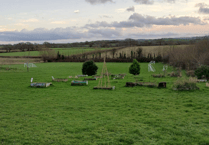A ‘SPECIAL’ planning approval has been granted for six new West Somerset homes to be developed in the ‘depths of the countryside’.
Somerset Council accepted a farm development half-a-mile from Combe Florey met class Q planning criteria, which was introduced by the Government nine years ago to allow agricultural buildings to be converted into residential dwellings without going through the full planning application process.
It means three barns at Hawkins Barton can be converted to six three-bedroom houses, with a fourth used for car parking.
But the decision went against the recommendation of parish councillors and a number of residents who also objected.
Cllr Adriana Truby, who holds the planning portfolio for the parish council, said there was concern over the density of the housing with six homes considered too many, and about an increase in traffic on the narrow lane leading into the village.
Villager Anthony Peel said he understood the need to support farmers and for further housing, but opposed the plans because access was via a narrow single track country lane where traffic had increased in recent years and vehicles often travelled too fast.
Mr Peel said: “This development is in the depths of the countryside and there are no public transport services.
“It is likely to further increase traffic flow, particularly at the beginning and end of the working day, as well as potential access to children’s school bus pick up/drop off points where there is inadequate parking for waiting vehicles.
“Given the traffic flows, it would be a dangerous lane for children to walk along, particularly in the dark of winter.”
Two other residents, Nielson and Julie Smith, said six more homes off the lane would severely compound the traffic problem, while the village was too small and in a rural conservation area to take an appreciable increase in housing.
Planning agent Amanda Burden, of Luscombe Maye, Totnes, said the farm buildings were former cattle sheds and a grain store and machinery sheds which used to support the existing business, but were now used only for low key agricultural storage.
Mrs Burden said: “We consider there will be negligible noise impacts from the development, but there will be an improvement to neighbours with the resulting agricultural activity being removed.
“The existing buildings are considered to be sound and can be converted using the existing fabric and structure.
“The insertion of new windows and doors will ensure the dwelling will achieve adequate lighting.
“The scheme reflects a contemporary cluster of modest sized dwellings which will provide much needed accommodation in this rural community.”
Council planning officer Helen Addison said the site was a concrete yard on which stood a group of modern-looking barns visible in the street scene.
Ms Addison said the council had been advised by Natural England that phosphate mitigation was not required because it was ‘permitted development’, which was outside the regulations.
The development would be subject to a community infrastructure levy reaching £156,500, of which 15 per cent could go to the parish council.





Comments
This article has no comments yet. Be the first to leave a comment.